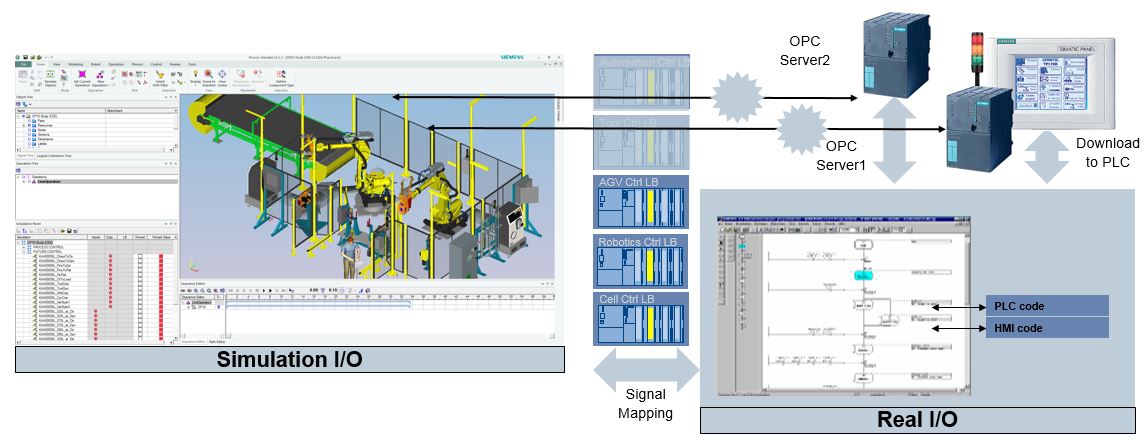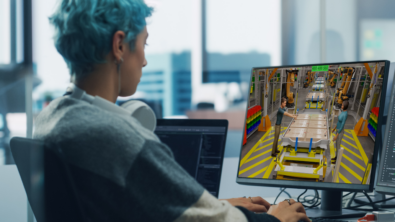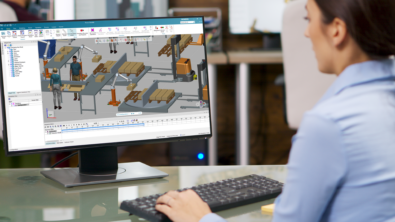Robotics and Automation Solutions in Aerospace & Defense Industries

Authored by David Introcaso, Business Consultant – Manufacturing Business Group, Siemens PLM Software
In this article David will describe the automation challenges and opportunities in the aerospace & defense industry and the exciting Siemens Tecnomatix solution capabilities in this area.
Airframe Manufacturing Trends
There are several industry trends that are impacting production activities and driving the need for the adoption of automation:
(1) The large order backlog at many airframe manufacturers is leading to the adoption of more complex automation (2) The growing global consumer market is creating new business opportunities, leading to operations now being set up overseas (3) Complex automation on the shop-floor allows for more efficient production, with fewer errors and less quality problems; (4) Product quality needs require manufacturers to identify potential issues before production; (5) Lightweighting – composite materials are being used to reduce weight and increase range (6) Steady search for ways to improve methods, reuse best practices and increase standardization are keys to implementing constant improvement. Implications of adopting complex automation in manufacturing environments
Implications of adopting complex automation in manufacturing environments
Those industry trends have significant manufacturing business implications. Manufacturers are required to comply with local facility requirements and operator safety requirements all while meeting their company’s volume production and quality targets.
Trends + Implications = Possibilities
To address the implications of adopting automation, manufacturers in A&D are starting to leverage best-in-class software technology. This may include: (1) Adopting 3D simulation tools; almost 100 percent of robot programming, for example, is validated offline; (2) Using advanced analysis such as collision reports, interference zone checks and weld-ability validation; (3) Automatic planning tools assist in reducing repetitive tasks and save engineering efforts; (4) Data management is critical to support multi-user and multi-project planning and also increases inter-company and supplier collaboration; and (5) Eventually, the use of templates and process libraries helps to ensure the use of standard best practices globally.

Solution in Action: Drilling & Riveting, Virtual Commissioning
Let’s start with drilling and riveting. This solution is applicable for robotic systems as well as fixed-frame specialized machines.
Siemens Drilling & Riveting solution:Process Simulate Robotics and Automation
Planning Tools
If you have thousands and thousands of rivets, how do you make sure you are accounting for all of them in the process plan? How do you group them into operations? And how do you create the locations to accurately Offline Program the riveting machine? You can use our Process Simulate software:
- Automatic part assignment
- Rivet grouping based on customizable search criteria
- Create process locations by projecting rivets on part geometry
Analysis Tools
The software allows you to do preliminary reach tests as well as tool search and validation. It is all about conducting an interactive tool search in libraries for tools that will work based on the data you have.
- Interactive machine reach tests
- Tool search and validation for optimized anvil selection
Collision Detection
The library will pick a tool that will avoid collision but now you can put the tool on the rivet locations and orient it in the right way to be sure you avoid a collision scenario.
- Effective collision detection and analysis tools
- Interactive smart analysis
- Create dynamic report for entire program optimized for simulation performance
Program Creation and Validation
Now you can create the offline program that can be downloaded to the robot or machine on the shop floor. With the software you are leveraging customized templates that you apply from one point to an entire set of rivets on the path that helps you to automate your programming and program faster. For example, for every rivet in a program segment, you may have a certain approach point, move in and do the rivet, and then back off a certain amount when you’re done. If you program that once for one rivet, you can apply that same template over and over again to all the rest of the rivets in that segment. Machine-specific cycles can also be applied based on pre-defined criteria.
- Robot controllers
- NC controller
- Customizable OLP commands
- Customizable templates applied per segment or entire program
- Download program to machine
- Upload program from shop floor
- Switch program between machines
Today’s highly automated and flexible manufacturing systems are all controlled by programmable logic controller (PLC) programs. These systems include sophisticated tooling, robots, transfer lines and other safety equipment. PLC programming allows manufacturers to alter production lines without having to completely retool the entire facility. Traditionally, however, whenever changes are made engineers still have to stop the production for an extended period of time while they debug the PLC programs against live equipment.
With the Tecnomatix Virtual Commissioning solution, you can debug your PLC code in a virtual environment before connecting it to the real equipment. By simulating and validating the code that controls your automation equipment virtually, you can confirm that it will work as expected and significantly reduce system startup time.

What are we trying to do with Virtual Commissioning? We are aiming to validate and verify the PLC code, test the robot programs, and test some safety “what-if?” scenarios. See the complete list of capabilities and key points below.

Intelligent Models – Robotics and Commissioning – Virtual Commissioning approach
The image below describes the approach we take with the Process Simulate software where we create logic in the simulation in the absence of the actual PLC code. When the actual PLC code becomes available you can then swap out what you did in the simulation and hook up to the real code on the real PLC and allow that to drive the simulation. In this way, the system helps you to prove out your PLC logic as it becomes available.
Summary
Process Simulate Drilling & Riveting and Virtual Commissioning
- Drilling & riveting: Reduce program and debug time
- Drilling & riveting: Faster evaluation of new production concepts
- Virtual commissioning: Eliminate operator safety issues
- Virtual commissioning: Minimize issues discovered during launch
If you like this article, please let us know with a “kudos” or a comment below.Thank you!


![Reshaping the world with digital manufacturing [VIDEO]](https://blogs.sw.siemens.com/wp-content/uploads/sites/7/2024/07/Zvi_2024_2-395x222.png)